Pothos are common houseplants that are easy to care for and hard to kill. This combination makes pothos a favorite among indoor gardeners of all experience levels.
Because of their low maintenance requirements and stunning foliage, some people often wonder if you could grow pothos in an aquarium. Let’s take a look at whether or not these plants can grow in a fish aquarium.
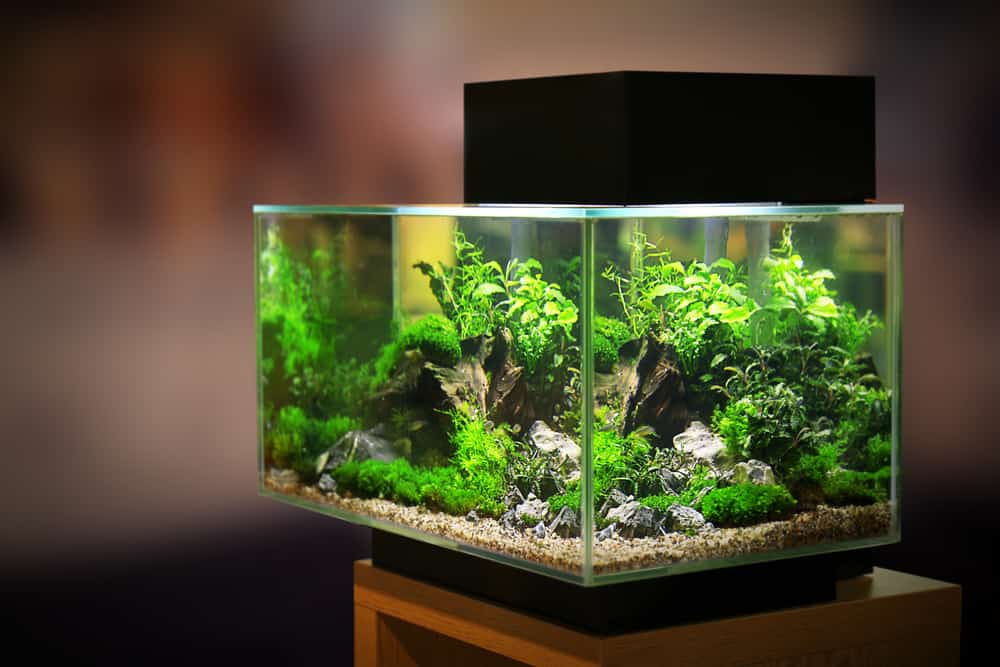
Table of Contents
Can pothos grow underwater?
Pothos can successfully grow underwater, though their growth rate is typically much slower than if you grew the plant in the ground. This is because of the lack of oxygen and CO2 that occurs naturally in the air. When grown underwater, the pothos doesn’t have access to these two components that are needed for optimal growth rate.
Another thing to consider is that when you grow pothos in an aquarium, their leaves won’t develop as well. This will result in the plant having small round leaves instead of the pothos’ iconic large foliage. What some people do instead is leave the pothos’ foliage out of water, while allowing only the roots and stems to live underwater.
While this plant can grow underwater, there are a few varieties of pothos that grow better in an aquarium than others. These include:
- Jade pothos
- Neon pothos
- Golden pothos
How long will pothos survive in water?
The average lifespan of a pothos is about 5 to 10 years, which is the same amount of time that it can live underwater. In order to achieve this lifespan, however, you will need to provide the underwater plant with the optimal care requirements.
This means regular water changes, fertilizing the plant, and ensuring it doesn’t develop any fungal diseases.
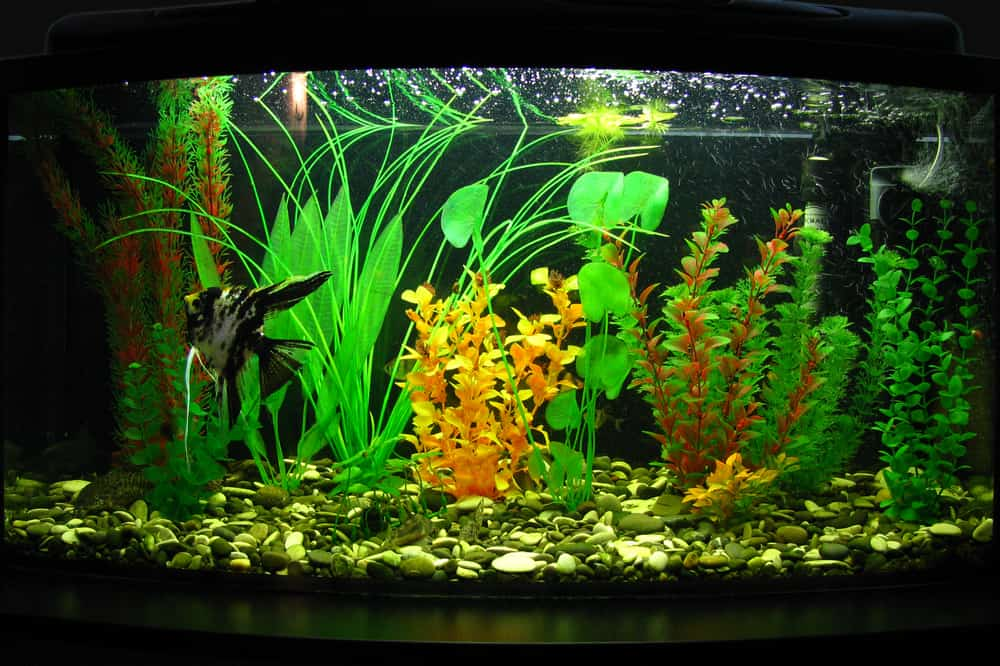
How to place pothos in an aquarium
Adding pothos in an aquarium isn’t a difficult process, but it does require certain steps to help increase the chance of success at growing these plants underwater. These steps include taking a cutting, rooting that cutting, and then positioning it into the aquarium.
1. Take cuttings
Cut a piece of stem off your pothos plant that is a few inches long and has several leaves. Remove the bottom leaves and then place the cutting in water that has been dechlorinated.
Make sure that when you take a pothos cutting, you do so from a healthy, disease-free plant. Additionally, choose a stem that is strong and not weak as you won’t want to propagate the pothos from a flimsy and diseased stock.
2. Root cuttings
Set the cutting in an area where it will be undisturbed and get indirect sunlight. Allow the cutting to grow roots, which can take several weeks. During this time, you will need to change the water about once a week or when it gets cloudy, whichever comes first.
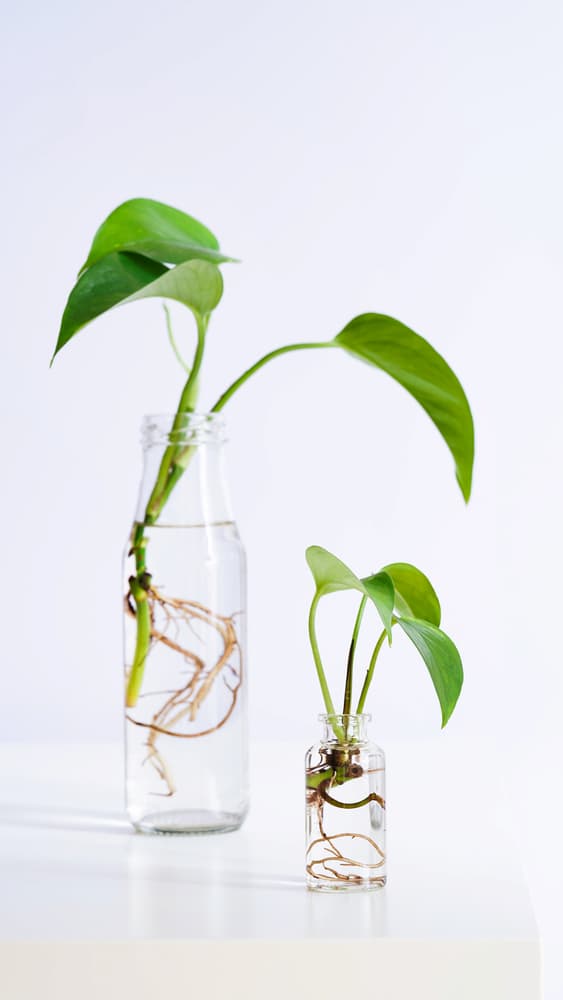
3. Transfer cuttings
Transfer the cutting into the aquarium once its roots reach 4 or so inches long.
It can take several weeks to over a month before the cutting starts to root, and even longer until these roots reach 4 inches long. However, it is important to wait until the roots are that length as it will help ensure the plant you are transferring will become established in the aquarium.
4. Anchor cuttings
Anchor the newly rooted plants in the aquarium so that only the pothos’ roots and part of their stems are underwater. Avoid submerging the leaves as this can cause the plant to not grow properly.
How to care for pothos in an aquarium
Even though pothos are not a hard plant to care for, they do require a little extra care when you grow them in an aquarium. With that said, however, most of the care requirements are similar or the same as if you were growing this plant in soil.
1. Provide the right light
Pothos need bright, indirect sunlight for the best growth. While they can handle some low light, it is not ideal for this plant. Position the aquarium in an area where the pothos can get bright light, but keep it out of direct sunlight.
Alternatively, artificial lights can be used to give the pathos the right amount of light. Remember, however, that even if artificial lighting is used, it still needs to be indirect. Direct light, both natural and artificial, will burn and scorch the plant’s leaves.
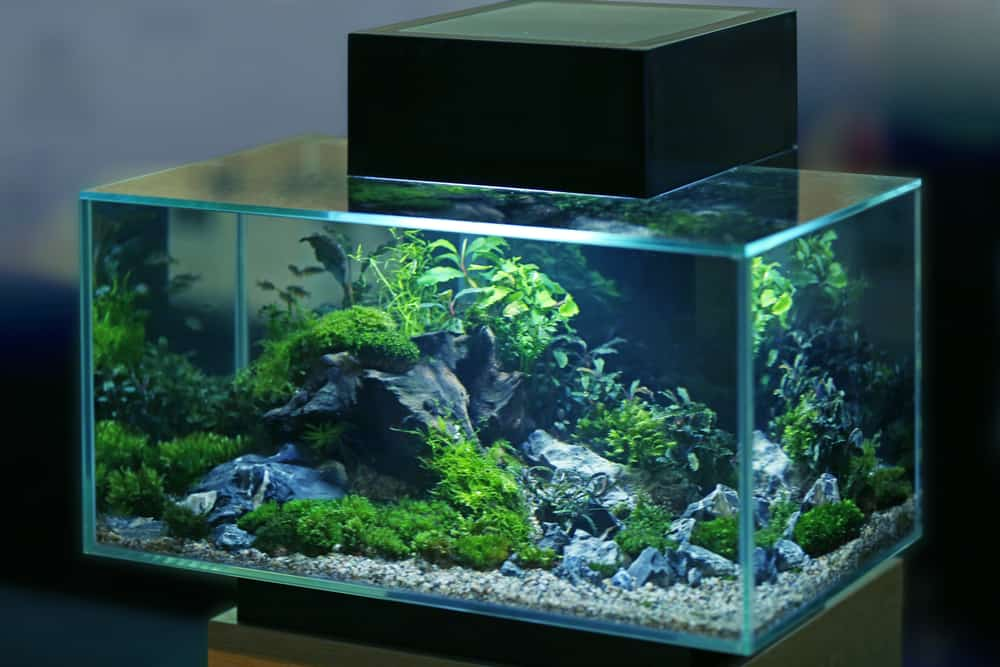
2. Trim roots
In order to keep the plant’s growth rate in check, and help prevent nutrient deficiency in the aquarium, you will need to prune back some of the roots. Simply snip the roots as close to the plant as possible using a pair of sharp pruning shears.
While you are pruning your pothos, take the time to inspect the roots and look for any dead or damaged roots. If you find any, go ahead and snip those off as well. This will help keep the plant healthy.
3. Feed the pothos
Pothos are not heavy feeders, but do need the occasional fertilizer to help encourage healthy growth and strong roots. Fertilize the pothos once a month with an all-purpose liquid fertilizer that is safe for use in aquariums. Make sure to follow the usage instructions found on the bottle.
My top pick: My preferred liquid fertilizer for pothos plants is the Triple 10 All Purpose Liquid Fertilizer (check the latest price here). It’s incredibly easy to use with just the right balance of nutrients for your pothos – not to mention that it’s great value.
4. Change the water regularly
The exact timeframe for when you need to change the water in the aquarium varies greatly on a wide array of factors, such as the size of the tank and what is currently living in it.
With that said, however, you know it’s time to change the water when it appears murky.
5. Maintain the temperature
Pothos growing in water will need a consistent air temperature of between 70 and 90 degrees Fahrenheit. In most cases, this is easy to achieve if you have the aquarium inside.
You should, however, refrain from setting up the aquarium in an area where the temps can change drastically, such as under a heating or cooling vent, or next to an exterior door.
Sudden and drastic temperature changes can cause the pothos to become stressed, which can take its toll on the plant’s health.

6. Keep the pothos out of saltwater
While pothos can successfully grow in water, they cannot grow in saltwater. Saltwater will quickly kill the plant and should never be added to saltwater tanks.
If you have a saltwater tank, choose an aquatic plant that can safely be grown in the salty water, such as Halimeda.
Advantages of having a pothos in your aquarium
Adding pothos in an aquarium provides a wide array of benefits for both you and the aquatic creatures living in the tank.
- Helps to control algae. Algae is a common problem in aquariums that occurs due to high levels of nitrate, a nutrient deficiency, or too much light. Algae not only reduces the appearance of your aquarium, but it also competes with the aquatic plants growing in the aquarium, which can have a negative effect on their overall health. How a pothos in an aquarium can help is with its ability to remove nutrients and nitrates from the water, which will reduce the chance of algae growing.
- Plant-eating fish are less likely to eat pothos compared to other plants. There are many different types of fish that will munch on just about any plant that you put in the aquarium. Pothos, however, grow strong roots that even the most aggressive plant-eating fish won’t bother touching. This means the pothos has a chance to grow and develop underwater better than some other aquatic plants.
- Gives fish cover to help them feel protected. Pothos are a wonderful option if you want to give your fish some cover. These plants grow faster than many other aquatic plants and have thick roots. These roots help to provide cover and hiding areas for fish. Pothos are even a good choice for breeding tanks, and the plant’s roots work well to hide juvenile fish.
- Improves aquarium’s appearance. Pothos are a well-beloved houseplant that can bring interest and texture to your home when grown in a pot. When you add it to your aquarium, you get the same stunning appearance only in water. Pothos give your aquarium a natural look that can help seamlessly blend the fish tank into your indoor décor.
Disadvantages of having a pothos in your aquarium
While it can provide several benefits, there are some disadvantages to growing pothos in an aquarium that you should consider beforehand.
- Sucks up too much nutrients. While the pothos ability to suck up nutrients can help aquariums, as the plant grows it can start to absorb too many of these vital nutrients. This can pose a potential problem for any other aquatic plants currently growing in the tank.
- Can quickly take over the aquarium. Because pothos are fast growing, their roots can quickly take over the aquarium. To prevent this from happening, you will need to regularly prune away roots. This will help keep the roots in your aquarium at a more manageable size.
- Has additional care requirements compared to if they grow in soil. As with anything else you put in your aquarium, adding pothos does require a bit more care and maintenance than if you had no plants in the fish tank.
- Toxic to people and pets. While pothos don’t pose a risk to fish, they can be dangerous to people and pets. This may not seem like a big deal at first, since you will be growing the pothos in an aquarium, but the foliage of this plant will likely be growing up and out of the tank, which means children, dogs, and cats could potentially come in contact with it.
Will pothos kill other aquarium plants?
While pothos don’t set out to kill other aquarium plants, they can be very good at absorbing nutrients and nitrates from the water. This will, unfortunately, have a negative effect on the health of other plants. In fact, it is not uncommon for nutrient deficiency to appear in tanks that have pothos growing.
The good news is that this can be relatively easy to control by simply pruning the pothos down a bit. This will require using pruning shears to snip off the underwater roots. You can also trim the above water foliage to help maintain the entire size of the plant.
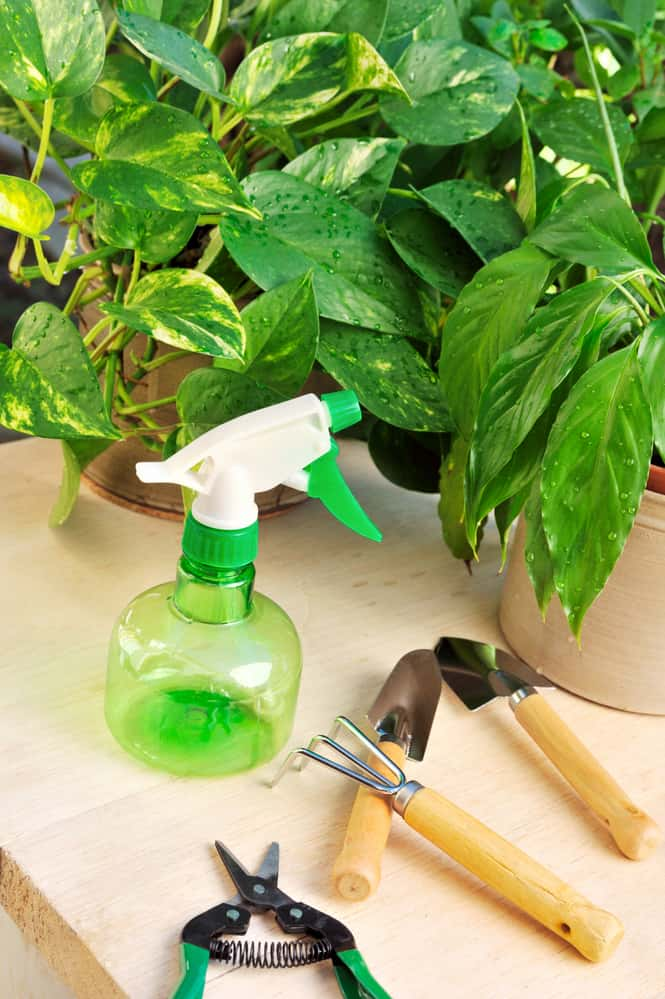
Are pothos toxic to fish?
While pothos are toxic to humans, cats, and dogs, they pose no risk to fish. Pothos even provide cover and a safe place for fish to lay their eggs. The roots of this plant will hide and protect the eggs until they hatch.
With that said, however, you should avoid allowing children and pets to come in contact with the out of water portions of the pothos. This means not allowing them to sniff, touch, or nibble on the foliage of the pothos in an aquarium.
Related: Are Pothos Toxic to Dogs (and What to Do If Your Pet Eats One)?
Can pothos destroy my aquarium?
While they can take over your aquarium if you don’t take the necessary precautions, pothos won’t destroy your aquarium. They can actually be extremely beneficial to your tank. The main concern with these plants has to do with them growing too fast and too much.
If you provide the pothos with the proper maintenance, you shouldn’t see any of the downsides of growing this plant in your aquarium. You do, however, have to be diligent to ensure the pothos don’t take over the aquarium and potentially harm the tank and the creatures living inside it.
Find out more about: 6 Simple Steps to Grow Pothos in Water Successfully
What to do if the pothos in my aquarium is turning yellow
When a pothos in an aquarium starts to turn yellow, it is a sure sign that the plant is getting too much light. You can easily correct this problem by moving the pothos or the entire aquarium out of direct light. If you are using artificial lighting, simply lower the light levels you are giving the plant.
Unfortunately, the pothos leaves that have turned yellow won’t turn back to their original emerald green color, but the new leaves that emerge will be green as long as the problem is fixed before they appear. If there are only a few leaves that have turned yellow, you can simply cut them off the plant.
Do pothos plants absorb ammonia in the aquarium?
Pothos plants can absorb ammonia in the aquarium, helping to prevent the levels from becoming too high and potentially harming the fish. In fact, pothos have the ability to remove anywhere from 10 to 50 percent of the ammonia in aquariums!
Fish naturally generate ammonia, which can actually harm them when the level of ammonia in the water becomes too high. When this happens, the fish are unable to get rid of the ammonia that is naturally occurring in their bodies. This will lead to the fish becoming stressed, their internal organs becoming damaged, and eventually the fish will die.
Meaning this is where having a pothos in your aquarium can save the day!
